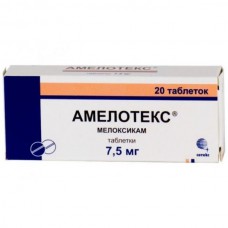Expiratiion date: 11/2022
The composition and form of issue:
Solution for intramuscular injection, 1 amp (1.5 ml) contains:
meloxicam 15 mg
excipients: meglumin plicopurpura poloxamer 188 sodium chloride glycerol sodium hydroxide solution 1 M water for injections
in ampoules of 1, 5 ml, in a contour acheikova packing 3 or 5 PCs the paper cartons 1 or 2 packs.
Tablets. 1 tablet contains:
meloxicam 7.5 or 15 mg
excipients: lactose monohydrate microcrystalline sodium citrate povidone crospovidone silicon dioxide colloidal magnesium stearate
in a contour acheikova packing 10 PCs. in cardboard pack 1 or 2 packs.
Description pharmaceutical form:
The solution for the/m introduction: transparent or with light opalescent liquid yellow with a greenish tint.
Tablets 7.5 mg: round, biconvex, pale yellow or pale yellow with a faint greenish tint tolerance of marbling and light roughness.
Tablets 15 mg: round, biconvex, with valium on one side, pale yellow or pale yellow with a faint greenish tint tolerance of marbling and light roughness.
Characteristic:
NPVS. Belongs to the class of oxicam derived anoliefo acid.
Pharmacokinetics:
The ingestion well absorbed from the gastrointestinal tract. Bioavailability is high at 89%. Simultaneous administration of food or antacids does not affect the absorption of the drug. Linking plasma protein — 99%. Passes through gistogematicalkie barriers penetrate the synovial fluid. Constant concentration in the blood plasma is reached after 3-5 days. The concentration in synovial fluid reaches the 50% of the maximum concentration in the plasma.
Excreted equally via the bowels and kidneys, mainly as metabolites. Through the intestines unchanged output of less than 5% of the magnitude of the daily dose, in the urine in an unmodified form the drug is detected only in trace amounts. T1/2 of meloxicam — 15-20 h. Plasma Cl — an average of 8 ml/min in the elderly, clearance of the drug is reduced. The volume of distribution is low and averages 11 l
Hepatic or renal insufficiency medium severity significant effect on the pharmacokinetics of meloxicam has not.
Description of the pharmacological action:
Selectively inhibits the enzymatic activity of COX-2. Inhibits synthesis of PG in the field of inflammation to a greater extent than in the mucous membrane of the stomach or the kidneys. Less common causes of erosive and ulcerative lesions of the gastrointestinal tract.
Indications:
- rheumatoid arthritis
- osteoarthrosis
- ankylosing spondylitis (Bechterew's disease)
- inflammatory and degenerative diseases of the joints, accompanied by pain syndrome.
Contraindications:
- hypersensitivity to the active substance or auxiliary components
- since the coronary artery bypass surgery
- uncompensated heart failure
- full or partial combination of bronchial asthma, recurrent polyposis of the nose and paranasal sinuses and intolerance of acetylsalicylic acid and other NSAIDs (including history)
- erosive-ulcerative changes of the gastric mucosa or duodenal ulcers, active gastrointestinal bleeding
- inflammatory bowel disease (ulcerative colitis, Crohn's disease)
- cerebrovascular bleeding or other bleeding
- severe hepatic impairment or active liver disease
- renal insufficiency in patients not undergoing dialysis (creatinine Cl <30 ml/min), a progressive kidney disease, including confirmed hyperkalemia
- pregnancy
- breastfeeding
- children up to age 15 years.
With caution — to reduce the risk of adverse effects, use the minimum effective dose as possible short course in IBS, cerebrovascular diseases, congestive heart failure, dyslipidemia/hyperlipidemia, diabetes, peripheral artery disease, Smoking, creatinine Cl <60 ml/min, anamnestic data about ulcerative lesions of the gastrointestinal tract, the presence of Helicobacter pylori infection in the elderly, long-term use of NSAIDs, frequent alcohol use, severe somatic diseases, concomitant therapy the following medications: anticoagulants (e.g. warfarin), antiplatelet agents (e.g. acetylsalicylic acid, clopidogrel), oral corticosteroids (e.g. prednisone), SSRIs (e.g. citalopram, fluoxetine, paroxetine, sertraline).
Side effect:
From the digestive system: nausea, vomiting, belching, abdominal pain, constipation or diarrhea, flatulence, increase in liver transaminases, hyperbilirubinemia, stomatitis, erosive-ulcerative lesions of the gastrointestinal tract, esophagitis, gastritis, colitis, perforation of the digestive tract, gastrointestinal bleeding (concealed or apparent), hepatitis.
From the nervous system: dizziness, vertigo, headache, tinnitus, confusion, drowsiness, disorientation, emotional lability.
The respiratory system: bronchospasm.
Organs of hematopoiesis: anemia, leukopenia, thrombocytopenia.
From the side of cardiovascular system: peripheral edema, increased blood pressure, rush of blood to the face and upper part of the chest, palpitations.
From the urinary system: swelling, gipercreatininemia, increasing the concentration of urea in the blood serum. In rare cases, acute renal failure, interstitial nephritis, albuminuria, hematuria.
From the sensory organs: conjunctivitis, impaired vision, including blurred vision.
With the skin: itching, skin rash, urticaria, photosensitivity, bullous eruptions, erythema multiforme, toxic epidermal necrolysis.
Allergic reactions: angioneurotic edema, anaphylactoid, anaphylactic reactions.
Additionally, the solution for the on/m introduction.
Local reactions: possible burning and pain at the injection site.
Drug interaction:
With simultaneous use with other NSAIDs increases the risk of ulcers and gastrointestinal bleeding.
Increases concentration of lithium in the plasma reduces the effectiveness of intrauterine contraceptive devices, anti-hypertensive drugs.
Indirect anticoagulants, tiklopidin, heparin, thrombolytics increase the risk of bleeding increases methotrexate myelodepressive effect diuretics increase risk of renal dysfunction cyclosporine increases nefrotoksicescoe effects cholestyramine accelerates the elimination. Mielotoksicskie HP increase symptoms gematotoksichnosti drug.
Method of application and doses:
The solution for the/m introduction.
In/m deep — 7, 5-15 mg 1 time per day. With a slight or moderate reduction in kidney function (Cl creatinine >25 ml/min), and cirrhosis of the liver in a stable clinical condition, dose adjustment is not required. The initial dose in patients with an increased risk of side effects — 7, 5 mg/day.
Maximum daily dose of 15 mg, in patients with severe renal insufficiency, hemodialysis — 7, 5 mg.
Tablets.
Inside, during a meal.
Rheumatoid arthritis — on 15 mg/day. Upon reaching the positive therapeutic effect the dose may be reduced to 7, 5 mg/day.
In osteoarthritis daily dose of 7 5 mg/day, if necessary dose increased to 15 mg/day.
In ankylosing spondylitis, in the dose of 15 mg/day.
Maximum daily dose of 15 mg.
In patients with increased risk of adverse reactions, the initial daily dose should not exceed 7, 5 mg.
In patients with end-stage renal disease on hemodialysis, the dose of the drug Amelotex should not exceed 7, 5 mg. in patients with mild or moderate impaired renal function (Cl creatinine >25 ml/min) a dose reduction is not required.
Overdose:
Symptoms: increased side effects.
Treatment: symptomatic. Specific antidotes and antagonists are not.
Special instruction:
In the occurrence of peptic ulcers or gastrointestinal bleeding, development of side effects in the skin and mucous membranes, the drug should be discontinued. Patients with a decrease in BCC and reduced glomerular filtration (dehydration, congestive heart failure, surgery) may appearance of clinically manifest chronic renal failure, which is completely reversible after discontinuation of the drug (in these patients, early treatment should be monitored daily diuresis and renal function). The steady and significant increase in transaminases and changes in other indicators of liver function the drug should be discontinued and conduct control tests. In patients with an increased risk of side effects, treatment start with doses of 7, 5 mg. In the terminal stage of chronic renal failure patients on dialysis, the dose should not exceed 7, 5 mg/day. During the period of treatment must be careful when driving and occupation of other potentially hazardous activities, require high concentration and psychomotor speed reactions (may cause dizziness and drowsiness).







